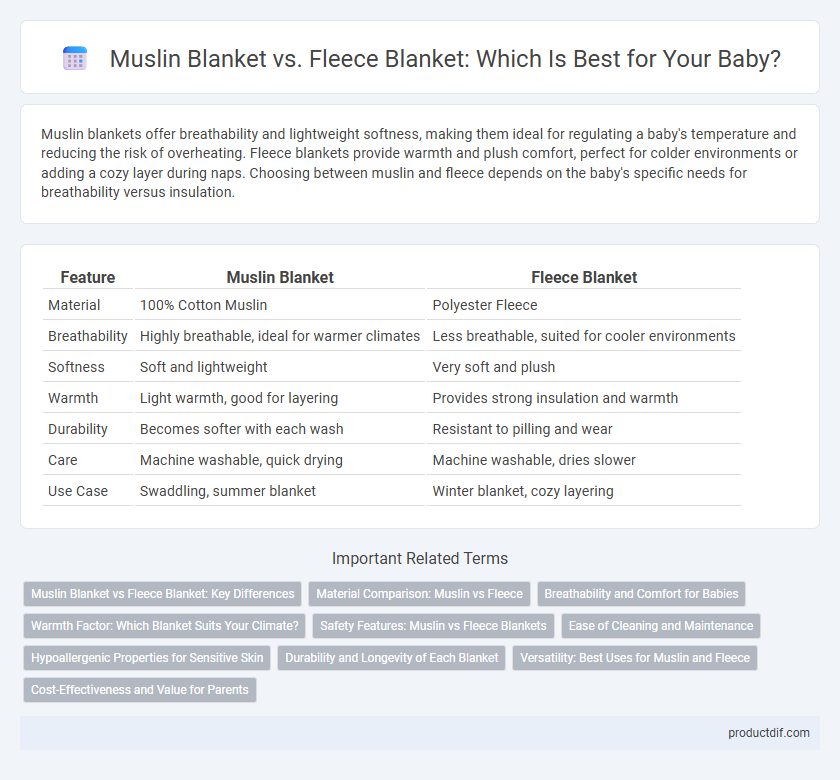Muslin blankets offer breathability and lightweight softness, making them ideal for regulating a baby's temperature and reducing the risk of overheating. Fleece blankets provide warmth and plush comfort, perfect for colder environments or adding a cozy layer during naps. Choosing between muslin and fleece depends on the baby's specific needs for breathability versus insulation.
Table of Comparison
| Feature | Muslin Blanket | Fleece Blanket |
|---|---|---|
| Material | 100% Cotton Muslin | Polyester Fleece |
| Breathability | Highly breathable, ideal for warmer climates | Less breathable, suited for cooler environments |
| Softness | Soft and lightweight | Very soft and plush |
| Warmth | Light warmth, good for layering | Provides strong insulation and warmth |
| Durability | Becomes softer with each wash | Resistant to pilling and wear |
| Care | Machine washable, quick drying | Machine washable, dries slower |
| Use Case | Swaddling, summer blanket | Winter blanket, cozy layering |
Muslin Blanket vs Fleece Blanket: Key Differences
Muslin blankets are lightweight, breathable, and made from natural cotton fibers, making them ideal for regulating a baby's temperature and preventing overheating. Fleece blankets, crafted from synthetic materials, offer superior warmth and softness but lack breathability, which can increase the risk of overheating for infants. Choosing between muslin and fleece blankets depends on climate, baby's sensitivity, and preference for natural versus synthetic fabric.
Material Comparison: Muslin vs Fleece
Muslin blankets are made from loosely woven cotton, offering breathability, softness, and lightweight comfort ideal for regulating a baby's temperature. Fleece blankets, constructed from synthetic fibers like polyester, provide superior warmth, moisture resistance, and durability, making them suitable for colder environments. Choosing between muslin and fleece depends on the desired balance of breathability versus insulation for infant care.
Breathability and Comfort for Babies
Muslin blankets offer superior breathability due to their lightweight, loosely woven cotton fabric, which helps regulate a baby's temperature and reduces the risk of overheating. Fleece blankets, made from synthetic fibers, provide plush warmth but can trap heat and moisture, potentially causing discomfort during warmer months. For optimal comfort and safe sleep, muslin blankets are preferred in mild climates, while fleece blankets are better suited for cooler environments.
Warmth Factor: Which Blanket Suits Your Climate?
Muslin blankets, made from breathable cotton, offer lightweight warmth ideal for mild to warm climates, preventing overheating while providing gentle comfort. Fleece blankets provide superior insulation with their dense synthetic fibers, making them perfect for colder environments that require maximum heat retention. When choosing between muslin and fleece, consider your local temperature and your baby's sensitivity to temperature changes to ensure optimal warmth and comfort.
Safety Features: Muslin vs Fleece Blankets
Muslin blankets offer superior breathability and natural fibers, reducing the risk of overheating and suffocation for infants, which is crucial for safe sleep environments. Fleece blankets, while soft and warm, can retain heat and pose a higher risk of overheating, making them less ideal for newborns. Choosing muslin blankets with hypoallergenic properties and lightweight, breathable fabrics enhances safety by preventing skin irritation and promoting airflow.
Ease of Cleaning and Maintenance
Muslin blankets are lightweight, breathable, and machine-washable, making them easy to clean and quick to dry, which helps prevent mildew and odors. Fleece blankets tend to retain lint and pet hair and may require gentle washing cycles to maintain softness, though they dry faster than heavier fabrics. Both materials offer convenient maintenance, but muslin's natural fibers provide superior breathability and hygienic drying advantages.
Hypoallergenic Properties for Sensitive Skin
Muslin blankets are made from loosely woven cotton fibers, making them breathable, lightweight, and naturally hypoallergenic, which reduces the risk of irritation for babies with sensitive skin. Fleece blankets, though warm and soft, can sometimes trap heat and moisture, potentially leading to skin irritation or allergies in sensitive infants. Choosing a muslin blanket provides gentle comfort and better airflow, minimizing allergic reactions and maintaining skin health in newborns.
Durability and Longevity of Each Blanket
Muslin blankets, made of tightly woven cotton, offer excellent breathability and become softer with each wash while maintaining durability over time. Fleece blankets, crafted from synthetic fibers, provide strong resistance to wear and tear and retain warmth even after multiple uses but may pill faster compared to muslin. When considering longevity, muslin blankets typically withstand frequent laundering better, making them ideal for everyday use in various conditions.
Versatility: Best Uses for Muslin and Fleece
Muslin blankets excel in breathability and lightweight comfort, making them ideal for swaddling, stroller covers, and light layering in warmer climates. Fleece blankets offer superior warmth and softness, perfect for cold-weather outings, nap times, and as cozy crib liners. Choosing between muslin and fleece depends on the baby's environment and the intended use, balancing temperature regulation and comfort needs.
Cost-Effectiveness and Value for Parents
Muslin blankets generally offer better cost-effectiveness due to their lightweight, breathable fabric that can be used year-round and easily cleaned, reducing the need for frequent replacements. Fleece blankets, while often more expensive, provide superior warmth and durability, making them valuable for colder climates and extended use. Parents seeking versatile, budget-friendly options tend to prefer muslin blankets, whereas those prioritizing warmth and longevity often invest in fleece.
Muslin Blanket vs Fleece Blanket Infographic

 productdif.com
productdif.com